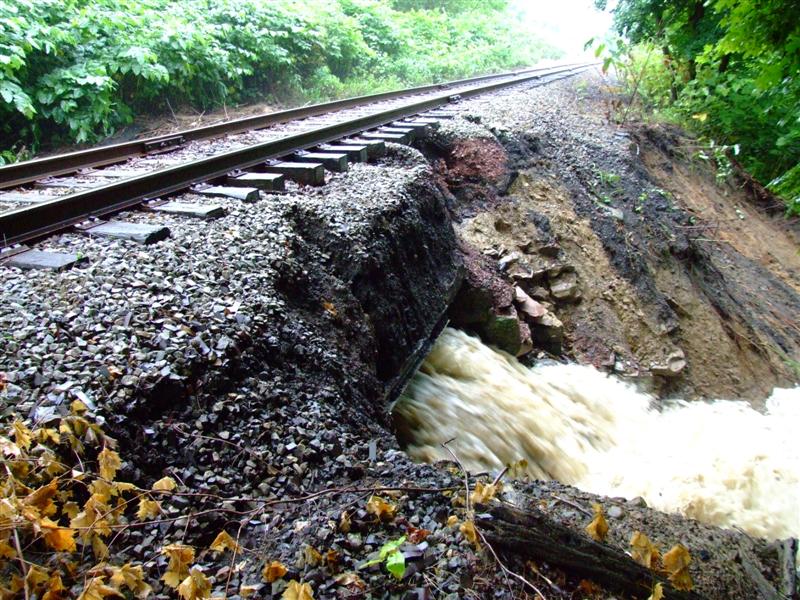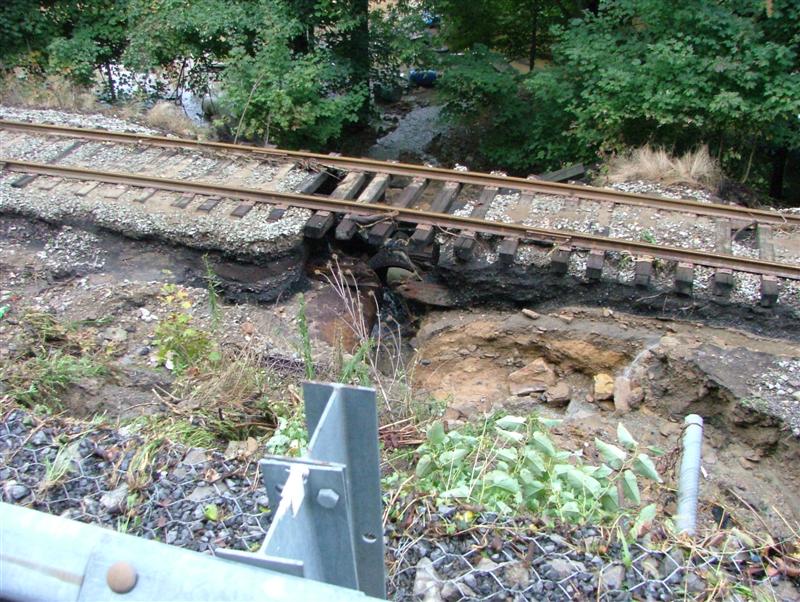Posts: 4,366
Threads: 62
Joined: Dec 2008
What's your opinion?
I've been research types of adhesives but haven't stumbled upon any discussion of whether or not to even use it. I would greatly appreciate some discussion on the topic. In other words, do I really need a ballast adhesive?
Tom
Life is simple - Eat, Drink, Play with trains
Occupation: Professional Old Guy (The government pays me to be old.)
Dinosaur Rider
Posts: 4,161
Threads: 174
Joined: Dec 2008
I'd recommend it. Otherwise, any time you attempt to re-rail a car on the track or do any work near the ballast, you'll risk disturbing it and getting those little particles everywhere. They're also likely to foul your turnout points and frogs if they are loose.
Its a tedious job to glue ballast but worth it.
Ralph
Posts: 10,686
Threads: 247
Joined: Dec 2008
If you don't glue it down it will never stay in place. A shirt cuff can do extensive damage. When the time comes that you need to use a vacuum cleaner on the layout your ballast will go up the tube. 
I use a 50/50 mix of Elmer's white glue and windshield washer solvent applied by dripping from a squeeze bottle (an old craft paint bottle is great)
I spray the ballast after I have it in place with Windex to make it wet then thoroughly saturate the ballast. It takes a day or two to dry and then I clean the surface of the rail, then paint the rail web and base with rust or blue grey depending on the location of the track.
Charlie
Posts: 4,366
Threads: 62
Joined: Dec 2008
I use white glue/water indoors also. This question applies to outdoor layouts.
Tom
Life is simple - Eat, Drink, Play with trains
Occupation: Professional Old Guy (The government pays me to be old.)
Dinosaur Rider
Posts: 1,333
Threads: 175
Joined: Dec 2008
It never occurred to me to not glue the ballast, mainly for the reasons mentioned -- i.e. that it would be messy, you could never move the layout, the ballast would never stay in place, etc.
After I've carefully placed the ballast in place, I soak it with rubbing alcohol (using a dropper). Then, I apply a 50-50 mix of white glue & water, also with a touch of dish detergent. The rubbing alcohol holds the ballast in place very well & prevents it from moving around when you apply the glue mix. Then it takes a day or so to dry. This method (which I found in a MRR article) is easy to do and very manageable.
Rob
Rob
<!-- m --><a class="postlink" href="http://www.robertrobotham.ca/">http://www.robertrobotham.ca/</a><!-- m -->
Posts: 3,021
Threads: 160
Joined: Dec 2008
Outdoors, I wouldn't, simply because I wonder what kind of adhesive could hold up to the weather. I'm not an outdoor railroader, but I would think that if you mixed some clay cat litter in with your ballast, it would kind of "glue" together the first time it rained.
--
Kevin
Check out my Shapeways creations!
3-d printed items in HO/HOn3 and more!
<!-- m --><a class="postlink" href="https://www.shapeways.com/shops/kevin-s-model-train-detail-parts">https://www.shapeways.com/shops/kevin-s ... tail-parts</a><!-- m -->
Posts: 4,161
Threads: 174
Joined: Dec 2008
FiatFan Wrote:I use white glue/water indoors also. This question applies to outdoor layouts.
Tom OH! OK...Never mind!  :oops:
Posts: 12,037
Threads: 579
Joined: Nov 2008
FiatFan Wrote:I use white glue/water indoors also. This question applies to outdoor layouts.
Tom I don't do outdoors, or large scale, so I never gave this any thought as to what anyone does. But it would seem to me to be a problem, although not as much as when using finer ballast. I can see animals, a stiff wind or rain moving things around. Is there any chance that using diluted yellow glue would work? It's water soluble, but waterproof when dried and does dry clear. Unlike with white glue though, you're not going to be undoing things easily. 
Don (ezdays) Day
Board administrator and
founder of the CANYON STATE RAILROAD
Posts: 5,263
Threads: 195
Joined: Apr 2009
I do not have a solution but a potential warning.
There is a kind of water proof white glue. You might think that would be the right thing. I did get some water proof white glue (a German brand) some years ago and did ballasting etc. with it. I noticed the mistake some month later when I tried to do some changes and the ballast did not come up after 5 minutes soaking with water.
The outcome was that water proof white glue is not really water proof. It needs some hours but it becomes slime again. Water proof white glue is not made to do e.g. outdoor furniture. It is only made to sustain one or two rain showers.
That means if you do ballasting with water proof white glue and you have a longer period of rain the glue is gone!
You should ask for permanent outdoor use as water proof only might be not good enough.
Reinhard
Posts: 10,686
Threads: 247
Joined: Dec 2008
If you are using a light colored ballast why not try mixing it with a vinyl cement, or grout, (dry) Once it is wet it should set OK.
I am not talking from experience with a small scale outdoor railroad, but it does work between bricks on a sidewalk. As with any railroad you can expect natures tragedies. Just another aspect that would make outdoor railroading interesting.
I spent 14 years with a 12 inch equals one foot railroad.This is what can happen:

The rain from Ivan caused that one.
2 years later a local thunderstorm dumped 6 inches of rain in a half hour and did this 2 miles east of the first washout:

I would guess no matter what you do, you will have to keep at it. 
Posts: 1,263
Threads: 45
Joined: Feb 2010
Tom;
I have a friend that has a rather large 1:20.3 scale outdoor logging railroad at his home and I know that he did not use any sort of glue to keep the ballast in place. I believe he used "Chicken Grit" for ballast that he purchases at a local farm supply company and it looks pretty good. Since it's a logging operation, in many places, he just filled in around the ties with a mixture of earth and ballast to get the look he wanted.
I remember him telling me that it would probably be a problem to actually try and glue the ballast down as with the extreme temperature changes we have here (like you do in Iowa), the track will often shift out of alignment in places over the winter and he simply has to make a few minor adjustments in the spring (adding more ballast if needed) in order to start running it again. Although I haven't talked to him for some time, I'm pretty sure that he probably had to replace most of the ballast this year after the 5+ inches of rain we had in one day this past June.
Biggest problem he ever had was the time that "Chip and Dale" decided to tunnel under a section of his railroad and that really caused him problems for a while, convincing them to move and getting the track back in to shape. Other than that, it's usually just a matter of removing leaves, small branches and a few weeds from the right of way and he's set to go.
I dabble a bit with the large scale stuff myself, although now I doubt that I'll ever get around to putting anything in the backyard, but were I to try it, I'd probably do like he did and just dig out the roadbed area, lay the track and then fill it in with some suitable size ballast.
The large scale, especially 1:20.3 (F scale) is really interesting. I love the large models of small locomotives, such as the Shay and Climax; not to mention the small Plymouth and Whitcomb industrial locomotives. The 1:29th scale equipment is fun too. Nothing like watching a large ALCo S-4 shoving around a couple of those large 50ft box cars.
Ed
"Friends don't let friends build Timesavers"
|




 :oops:
:oops:

